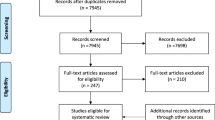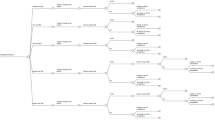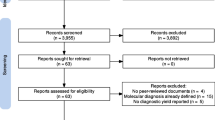Abstract
Genetic disorders are clinically diverse and genetically heterogeneous, and are traditionally diagnosed based on an iterative phenotype-guided genetic assessment. However, such diagnostic approaches are long (diagnostic odysseys are common), misdiagnoses occur frequently, and diagnostic rates are low. Massively parallel sequencing (MPS) technologies may improve diagnostic rates and reduce the time to diagnosis for patients with suspected genetic disorders; however, MPS technologies are expensive and the health economic evidence base to support their use is limited. Several studies have compared the costs of traditional and MPS diagnostic pathways for patients with suspected genetic disorders, however costing methods and diagnostic scenarios are heterogeneous across studies. We conducted a literature review to identify and summarise information on these costing methods and diagnostic scenarios. Relevant studies were identified in MEDLINE, EMBASE, EconLit, University of York Centre for Reviews and Dissemination and the Cochrane Library, from 2010 to 2018. Twenty-four articles were included in the review. We observed considerable heterogeneity across studies with respect to the selection of items of resource use used to derive total diagnostic pathway cost estimates. We also observed structural differences in the diagnostic scenarios used to compare the traditional and MPS diagnostic pathways. There is a need for guidelines on the costing of diagnostic pathways to encourage the use of consistent methods. More micro-costing studies that evaluate diagnostic service delivery are also required. Greater homogeneity in costing approaches would facilitate more reliable comparisons between studies and improve the transferability of cost estimates across countries.

Similar content being viewed by others

References
National Institute of Health. What are genetic disorders? National Human Genome Research Institute. 2015. https://www.genome.gov/19016930/faq-about-genetic-disorders/. Accessed 23 Jan 2019.
Genetic Disorders UK. About genetic disorders. 2019. https://www.geneticdisordersuk.org/aboutgeneticdisorders. Accessed 23 Jan 2019.
Ewans LJ, Schofield D, Shrestha R, Zhu Y, Gayevskiy V, Ying K, et al. Whole-exome sequencing reanalysis at 12 months boosts diagnosis and is cost-effective when applied early in Mendelian disorders. Genet Med. 2018;20(12):1564–74.
Vissers L, van Nimwegen KJM, Schieving JH, Kamsteeg EJ, Kleefstra T, Yntema HG, et al. A clinical utility study of exome sequencing versus conventional genetic testing in pediatric neurology. Genet Med. 2017;19(9):1055–63.
Glossary of genomics terms. JAMA. 2013;309(14):1533–5. https://doi.org/10.1001/jama.2013.2950
Iglesias A, Anyane-Yeboa K, Wynn J, Wilson A, Cho MT, Guzman E, et al. The usefulness of whole-exome sequencing in routine clinical practice. Genet Med. 2014;16(12):922.
Palmer EE, Schofield D, Shrestha R, Kandula T, Macintosh R, Lawson JA, et al. Integrating exome sequencing into a diagnostic pathway for epileptic encephalopathy: evidence of clinical utility and cost effectiveness. Mol Genet Genom Med. 2018;6(2):186–99.
ACMG Board of Directors. Clinical utility of genetic and genomic services: a position statement of the American College of Medical Genetics and Genomics. Genet Med. 2015;17(6):505.
Lenhard W, Breitenbach E, Ebert H, Schindelhauer-Deutscher H-J, Henn W. Psychological benefit of diagnostic certainty for mothers of children with disabilities: lessons from Down syndrome. Am J Med Genet Part A. 2005;133(2):170–5.
Adams DR, Eng CM. Next-generation sequencing to diagnose suspected genetic disorders. N Engl J Med. 2018;379(14):1353–62.
Baynam G, Pachter N, McKenzie F, Townshend S, Slee J, Kiraly-Borri C, et al. The rare and undiagnosed diseases diagnostic service—application of massively parallel sequencing in a state-wide clinical service. Orphanet J Rare Dis. 2016;11(1):77.
Taylor JC, Martin HC, Lise S, Broxholme J, Cazier J-B, Rimmer A, et al. Factors influencing success of clinical genome sequencing across a broad spectrum of disorders. Nat Genet. 2015;47(7):717.
Wang J, Gotway G, Pascual JM, Park JY. Diagnostic yield of clinical next-generation sequencing panels for epilepsy. JAMA Neurol. 2014;71(5):650–1.
Lee H, Deignan JL, Dorrani N, Strom SP, Kantarci S, Quintero-Rivera F, et al. Clinical exome sequencing for genetic identification of rare Mendelian disorders. JAMA. 2014;312(18):1880–7.
NHS England. NHS genomic medicine service. 2018. https://www.england.nhs.uk/genomics/nhs-genomic-med-service/. Accessed 24 Jan 2019.
Alam K, Schofield D. Economic evaluation of genomic sequencing in the paediatric population: a critical review. Eur J Hum Genet. 2018;26(9):1241–7.
Schwarze K, Buchanan J, Taylor JC, Wordsworth S. Are whole-exome and whole-genome sequencing approaches cost-effective? A systematic review of the literature. Genet Med. 2018;20(10):1122–30.
Mogyorosy Z, Smith P. The main methodological issues in costing health care services: a literature review. York: Center for Health Economics; 2005.
Raftery J. Costing in economic evaluation. BMJ. 2000;320(7249):1597.
Drummond M, Barbieri M, Cook J, Glick HA, Lis J, Malik F, et al. Transferability of economic evaluations across jurisdictions: ISPOR Good Research Practices Task Force report. Value Health. 2009;12(4):409–18.
Drummond MF, Sculpher MJ, Claxton K, Stoddart GL, Torrance GW. Methods for the economic evaluation of health care programmes. Oxford: Oxford University Press; 2015.
Greenhalgh T, Peacock R. Effectiveness and efficiency of search methods in systematic reviews of complex evidence: audit of primary sources. BMJ. 2005;331(7524):1064–5.
Shemilt I, Thomas J, Morciano M. A web-based tool for adjusting costs to a specific target currency and price year. Evid Policy J Res Debate Pract. 2010;6(1):51–9.
Husereau D, Drummond M, Petrou S, Carswell C, Moher D, Greenberg D, et al. Consolidated health economic evaluation reporting standards (CHEERS)—explanation and elaboration: a report of the ISPOR health economic evaluation publication guidelines good reporting practices task force. Value Health. 2013;16(2):231–50.
Buchanan J, Wordsworth S. Welfarism versus extra-welfarism: can the choice of economic evaluation approach impact on the adoption decisions recommended by economic evaluation studies? PharmacoEconomics. 2015;33(6):571–9.
The World Bank. World Bank Country and Lending Group. 2019. https://datahelpdesk.worldbank.org/knowledgebase/articles/906519-world-bank-country-and-lending-groups. Accessed 29 Jan 2019.
Sabatini LM, Mathews C, Ptak D, Doshi S, Tynan K, Hegde MR, et al. Genomic sequencing procedure microcosting analysis and health economic cost-impact analysis: a report of the association for molecular pathology. J Mol Diagn. 2016;18(3):319–28.
Tsiplova K, Zur RM, Marshall CR, Stavropoulos DJ, Pereira SL, Merico D, et al. A microcosting and cost-consequence analysis of clinical genomic testing strategies in autism spectrum disorder. Genet Med. 2017;19(11):1268–75.
Nolan D, Carlson M. Whole exome sequencing in pediatric neurology patients: clinical implications and estimated cost analysis. J Child Neurol. 2016;31(7):887–94.
Joshi C, Kolbe DL, Mansilla MA, Mason SO, Smith RJ, Campbell CA. Reducing the cost of the diagnostic odyssey in early onset epileptic encephalopathies. Biomed Res Int. 2016;2016:6421039.
Shashi V, McConkie-Rosell A, Rosell B, Schoch K, Vellore K, McDonald M, et al. The utility of the traditional medical genetics diagnostic evaluation in the context of next-generation sequencing for undiagnosed genetic disorders. Genet Med. 2014;16(2):176–82.
Soden SE, Saunders CJ, Willig LK, Farrow EG, Smith LD, Petrikin JE, et al. Effectiveness of exome and genome sequencing guided by acuity of illness for diagnosis of neurodevelopmental disorders. Sci Transl Med. 2014;6(265):265ra168.
Schofield D, Alam K, Douglas L, Shrestha R, MacArthur DG, Davis M, et al. Cost-effectiveness of massively parallel sequencing for diagnosis of paediatric muscle diseases. NPJ Genom Med. 2017;2(1):4.
Walsh M, Bell KM, Chong B, Creed E, Brett GR, Pope K, et al. Diagnostic and cost utility of whole exome sequencing in peripheral neuropathy. Ann Clin Transl Neurol. 2017;4(5):318–25.
Howell KB, Eggers S, Dalziel K, Riseley J, Mandelstam S, Myers CT, et al. A population-based cost-effectiveness study of early genetic testing in severe epilepsies of infancy. Epilepsia. 2018;59(6):1177–87.
Sagoo GS, Norbury G, Mohammed S, Kroese M. Whole exome sequencing in clinical genetics—a health economic evaluation. Cambridge: PHG Foundation; 2017.
Demos M, Guella I, McKenzie MB, Buerki SE, Evans DM, Toyota EB, et al. Diagnostic yield and treatment impact of targeted exome sequencing in early-onset epilepsy. bioRxiv. 2017;2017:139329.
Stark Z, Schofield D, Alam K, Wilson W, Mupfeki N, Macciocca I, et al. Prospective comparison of the cost-effectiveness of clinical whole-exome sequencing with that of usual care overwhelmingly supports early use and reimbursement. Genet Med. 2017;19(8):867–74.
Tan TY, Dillon OJ, Stark Z, Schofield D, Alam K, Shrestha R, et al. Diagnostic impact and cost-effectiveness of whole-exome sequencing for ambulant children with suspected monogenic conditions. JAMA Pediatr. 2017;171(9):855–62.
van Nimwegen KJ, Schieving JH, Willemsen MA, Veltman JA, van der Burg S, van der Wilt GJ, et al. The diagnostic pathway in complex paediatric neurology: a cost analysis. Eur J Paediatr Neurol. 2015;19(2):233–9.
Vrijenhoek T, Middelburg EM, Monroe GR, van Gassen KL, Geenen JW, Hövels AM, et al. Whole-exome sequencing in intellectual disability; cost before and after a diagnosis. Eur J Hum Genet. 2018;26(11):1566.
van der Wilt GJ, van Nimwegen KJM, Vissers LELM, Schieving JH, Willemsen MAAP, Veltman JA, et al. Cost-effectiveness of diagnostic whole exome sequencing in complex paediatric neurology. Nijmegen: Radboud University Nijmegen; 2017.
Monroe GR, Frederix GW, Savelberg SM, de Vries TI, Duran KJ, van der Smagt JJ, et al. Effectiveness of whole-exome sequencing and costs of the traditional diagnostic trajectory in children with intellectual disability. Genet Med. 2016;18(9):949–56.
Cordoba M, Rodriguez-Quiroga SA, Vega PA, Salinas V, Perez-Maturo J, Amartino H, et al. Whole exome sequencing in neurogenetic odysseys: an effective, cost- and time-saving diagnostic approach. PLoS One. 2018;13(2):e0191228.
Richards J, Korgenski EK, Taft RJ, Vanderver A, Bonkowsky JL. Targeted leukodystrophy diagnosis based on charges and yields for testing. Am J Med Genet A. 2015;167A(11):2541–3.
Sawyer SL, Schwartzentruber J, Beaulieu CL, Dyment D, Smith A, Chardon JW, et al. Exome sequencing as a diagnostic tool for pediatric-onset ataxia. Hum Mutat. 2014;35(1):45–9.
Lazaridis KN, Schahl KA, Cousin MA, Babovic-Vuksanovic D, Riegert-Johnson DL, Gavrilova RH, et al. Outcome of whole exome sequencing for diagnostic odyssey cases of an individualized medicine clinic: the Mayo Clinic experience. Mayo Clin Proc. 2016;91(3):297–307.
Dragojlovic N, Elliott AM, Adam S, van Karnebeek C, Lehman A, Mwenifumbo JC, et al. The cost and diagnostic yield of exome sequencing for children with suspected genetic disorders: a benchmarking study. Genet Med. 2018;20(9):1013–21.
Dragojlovic N, van Karnebeek CD, Ghani A, Genereaux D, Kim E, Birch P, et al. The cost trajectory of the diagnostic care pathway for children with suspected genetic disorders. Genet Med. 2019. https://doi.org/10.1038/s41436-019-0635-6(Epub 29 Aug 2019).
Retterer K, Juusola J, Cho MT, Vitazka P, Millan F, Gibellini F, et al. Clinical application of whole-exome sequencing across clinical indications. Genet Med. 2016;18(7):696.
Stark Z, Schofield D, Martyn M, Rynehart L, Shrestha R, Alam K, et al. Does genomic sequencing early in the diagnostic trajectory make a difference? A follow-up study of clinical outcomes and cost-effectiveness. Genet Med. 2019;21:173–80.
Schofield D, Rynehart L, Shresthra R, White SM, Stark Z. Long-term economic impacts of exome sequencing for suspected monogenic disorders: diagnosis, management, and reproductive outcomes. Genet Med. 2019;21:2586–93.
Regier DA, Friedman JM, Makela N, Ryan M, Marra CA. Valuing the benefit of diagnostic testing for genetic causes of idiopathic developmental disability: willingness to pay from families of affected children. Clin Genet. 2009;75(6):514–21.
Frappier J, Tremblay G, Charny M, Cloutier LM. Costing bias in economic evaluations. J Med Econ. 2015;18(8):596–9.
Xu X, Nardini HKG, Ruger JP. Micro-costing studies in the health and medical literature: protocol for a systematic review. Syst Rev. 2014;3(1):47.
Heerey A, McGowan B, Ryan M, Barry M. Microcosting versus DRGs in the provision of cost estimates for use in pharmacoeconomic evaluation. Expert Rev Pharmacoecon Outcomes Res. 2002;2(1):29–33.
Funding
PF is funded by the German Academic Scholarship Foundation. JB and SW are funded by the National Institute for Health Research Oxford Biomedical Research Centre.
Author information
Authors and Affiliations
Contributions
PF initiated and led the study, designed the literature review, extracted and tabulated data, interpreted the results and drafted the manuscript. JB and SW assisted with the interpretation of the results, and reviewed and modified the manuscript for important intellectual content. All authors approved the final manuscript. PF acts as the overall guarantor for this work.
Corresponding author
Ethics declarations
Conflict of interest
Patrick Fahr declares no conflicts of interest. James Buchanan and Sarah Wordsworth are co-applicants of a project funded through Genome British Columbia’s GeneSolve program and Illumina, and have received travel funding from Illumina to attend conferences.
Electronic supplementary material
Below is the link to the electronic supplementary material.
Rights and permissions
About this article
Cite this article
Fahr, P., Buchanan, J. & Wordsworth, S. A Review of Health Economic Studies Comparing Traditional and Massively Parallel Sequencing Diagnostic Pathways for Suspected Genetic Disorders. PharmacoEconomics 38, 143–158 (2020). https://doi.org/10.1007/s40273-019-00856-8
Published:
Issue Date:
DOI: https://doi.org/10.1007/s40273-019-00856-8



